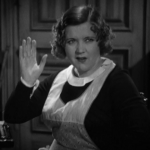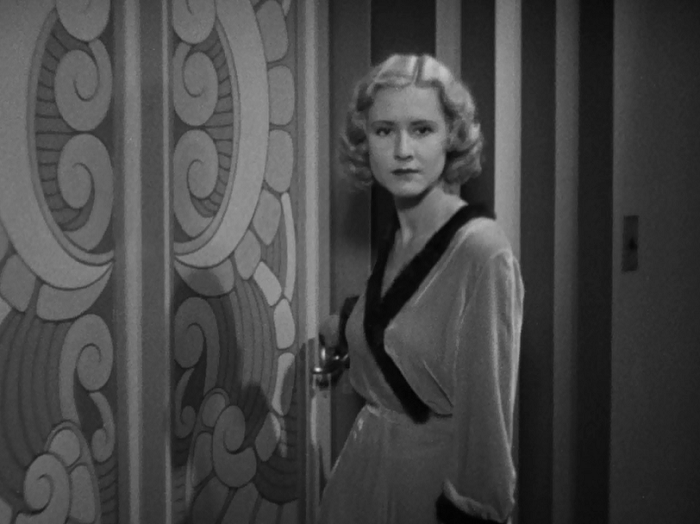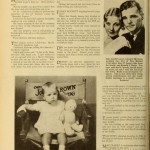 |
 |
 |
| Cassie … Jean Harlow |
Gladys … Mae Clarke |
Dot … Marie Prevost |
Proof That It’s Pre-Code
- Drinking by the ill-mannered, with one upper crust youth noting, “Most of the girls around here like to compete to see who can get blotto first!”
- Several colorful euphemisms for the rear end, including “whatsit”.
- Do you like to watch movies that are at least 50% women undressing? Because, oh boy, have I got a flick for you.

The real question is not how many times does the cast undress throughout the film, but how long they manage to keep those outfits on.
Three Wise Girls: Love Among Liars
“Want a ride, sister?”
“I’m just walking back from one.”
Men are pigs. We’ve established this at some point before, right? Especially back in the 1930s, when women having the right to vote was barely over a decade old. Women had to rely on men to be the breadwinners, as every position of the social strata above secretary was almost solely open to the male gender.
So how do you make some money if you’re a woman? Either you work your ass off, enter a scandalous career field, or find a man with money and slowly deprive him of it. None of these are particularly appealing for a woman of virtue except the first, and during the Depression that usually meant several degrees of sexual harassment.
That’s the trouble that Cassie finds herself in. A small town girl, the only thing men seem to want from her is a good time. She’s too good for a good time and instead daydreams of a career that will allow her to take care of her mom and impress the other people in town. Since being a soda jerk ain’t doing it, she makes the fateful decision to move to the city.

Let’s be honest, Cassie’s biggest problem is that she looks a lot like Jean Harlow.
And so now she’s a soda jerk in New York City, though she’s not long for the career. “The manager tried taking my waist measurements,” she sniffs. On the way out she meets Jerry Dexter (Walter Byron), a rich wastrel who’s a fan of the drink and teaches her now former employer a lesson in paying salaries. When he doesn’t hit on her, she’s surprisingly miffed.
Cassie’s roommate is Dot. Dot’s a self starter who’s get-rich-eventually scheme involves mailing every person in America and asking for a dollar. She has no cash, loves food, and always has to pick between the two.
Cassie’s pal is Gladys. She gets Cassie a job as a model in a department store which somehow involves fewer incidents of sexual harassment. But Gladys is unhappy as she’s in love with a rich man named Arthur who still has a pesky wife around. She’s in constant turmoil, stuck in a place that makes her miserable.

Our titular girls.
So there you go, you have Cassie’s Gallant and Goofus of dating advice. As Jerry keeps popping up and Cassie has to decide whether to go along with his polite pursuit, Dot tells her to do it for the security and Gladys tells her not to because love makes you miserable. Cassie’s own beliefs are far more rigid, and navigating between what she wants and what she believes, especially once she discovers that Jerry is married, is going to be an especially troublesome path.
Those out there who are bigger fans of Harlow’s more vampish persona– the feisty gold diggers of Red-Headed Woman and Dinner at Eight for example– probably won’t find much about this performance to satiate them. Her Cassie here is a conservative girl, one whose desires to make her mother proud aren’t what you usually get in these sorts of pictures. As such Harlow’s wonderfully weary and nuanced, making quite palpable her aching desire to live her life on her own terms.
The rest of the cast is killer as well. Mae Clarke nearly steals the show as Gladys, a character who’s endlessly generous and kind but completely broken in spirit at the same time. Clarke makes this devotion into an asset, as we can see the broken dreams in her eyes as she suffers through her one indignity after another.

You know what they say, unhappy in life, uh, unhappy in… uh…
Marie Prevost, as the other girl, is also excellent. After working throughout the 20s as a model flapper, Prevost had something akin to a breakdown and packed on the pounds. Thankfully this made her a cinch as comic relief, the star’s best friend who can crack wise with a freeing glee.
The best scene in the film is between the three actresses in Dot and Cassie’s apartment. Jerry’s marital status has been unveiled, and both Dot and Gladys pitch their case to Cassie. Dot calls Gladys a hypocrite as someone who doesn’t have to worry about money, while Gladys mournfully admits she’s envious of Dot’s hardy but virtuous existence. The three play off each other wonderfully, and it’s a shame they don’t get many more scenes together.
The other actors are fine as well, with Byron managing to be delightfully offbeat as a suitor who never seems sure of which gear he should be switching to. Natalie Moorhead is sadly underused as Jerry’s wife as the character desperately needed another scene where we see her finally convinced of committing to divorce. As it is, she becomes a momentary thorn who vanishes abruptly. Andy Devane pops up for a nice two second bit part as well, which is always nice.

The love yacht, exciting and new.
Spoilers.
The film’s finale involves the usual romcom confusion as Jerry mistakenly believes that Arthur and Cassie have been hooking up, with Cassie’s conservative tendencies all about her manipulating her. What’s interesting is that Arthur, who’s repeatedly attempted to seduce Cassie by the finale, gets away with this and other drunken harassments.
Cassie elects not to tell Gladys about Arthur’s attempts, believing that knowing the truth would kill her. Funny that it’s phrased that way, since Gladys opts to kill herself when Arthur ditches her without a word of goodbye and reconciles with his wife. Clarke is beautiful here, taking a kind and generous character who’s completely wrecked her own internal morality and sees no reason to continue.
From there it’s almost a jarring finale. Cassie moves back to Chillicothe and suddenly reunites with Jerry when he shows up with a paper showing that he’s to be divorced. The moral of the story seems to be to love wisely; Gladys pays the price for sticking with a married man, where Cassie reaps rewards for waiting for him to get a divorce. Dot, meanwhile, meets a nice guy with a steady job, which was all she apparently needed. You can’t choose who you fall in love with, but you can navigate to the final product with a degree of pride.
End spoilers.

Going for a ride.
Having said all this about broken dreams and yearning souls, it should be mentioned that the movie often sizzles with dialogue and good humor. While definitely filled with another hefty tale of women struggling in the system, it’s nice to see Cassie’s pluck not just coming from self preservation but a sense of pride and intelligence. The wonderful characters and actors in Three Wise Girls elevate this soap opera into a nice little slice of a much different world.
Gallery
Here are some extra screenshots I took. Click on any picture to enlarge!
Trivia & Links
- Three Wise Girls was Harlow’s first role in which she received top billing, and her last picture for any studio other than MGM. TCMDB also notes that Harlow was unhappy with the role and especially hew makeup.
- Laura’s Miscellaneous Musings calls this one entertaining and points out that Clarke and Harlow were also both in a popular movie from just a year earlier: The Public Enemy.

People reading newspapers in soda shops. Those were the days!
- Cinema OCD is disappointed for this one, calling it ‘sappy rather than snappy’. She wraps up with this nice passage:
Of course, the entire premise of this film–that a girl could hook an unhappily married rich man, secure his divorce and walk happily off into the sunset– would have been impossible a few years later. Though Harlow’s character is more virtuous than Clark’s (she actually breaks off the relationship when she finds out he’s married rather than using the money to keep her poor mother in furs), she would still be a home wrecker in the Code era. Three Wise Girls fits into the working single girl as hero mold that so many pre-code pictures did and though it offers no solution to their problems but an honest and happy marriage, at least its willing to admit in a realistic way, that a single girl did have problems.
- Andre Sennwald tackles this one for the Times and dismisses it swiftly. An excerpt:
It shows in easy symbols that gingham is plain but honest. The girl who climbs into the lap of luxury must take the chance of tumbling out—with, in this instance, a phial of poison in one hand.

I like how there’s nothing else on the bottle, it’s just the generic brand of poison.
- 10k Bullets calls this enjoyable and runs down the rest of the Columbia pre-Code collection for ya.
- Nice lobby cards and a poster from Dr. Macro.
- The Lost Art of Being a Dame looks at Marie Prevost’s sad life and tragic death, and does some good in dispelling the old rumor that she died being eaten by her pet dachshund.
Primary Sources
Thanks to Lantern, there are hundreds of issues of fan magazine and industry journals from the pre-Code era available for free. Here are some related articles; click on the ‘View Full Sized Image’ in the bottom right to view!
Awards, Accolades & Availability
- This film is available on Amazon and can be rented from Classicflix.
 |
Comment below or join our email subscription list on the sidebar!Home | All of Our Reviews | What is Pre-Code? |











8 Comments
Dixie Laite · November 8, 2013 at 3:53 am
Thanks so much for the mention! I freakin’ LOVE your site. It’s so great to find a site on such a wonderful topic done in such a wonderful way. I salute you. A lot.
Danny · November 8, 2013 at 9:43 pm
Thanks, Dixie! Keep doing all the awesome stuff you do!
Jen - Flapper Flickers + Silent Stanzas · November 8, 2013 at 6:51 am
One of my favorite pre-Codes, and possibly my favorite Harlow movie. Marie Prevost is a darling, too! 🙂
Danny · November 8, 2013 at 9:42 pm
Prevost is adorable here, and I was kind of bummed out to see what turns her career made afterward. This movie and Ladies of Leisure make her the ideal best friend for anyone, and she’s irresistible in both. 🙂
Andrew · November 8, 2013 at 12:22 pm
I just remember the scene about Cassie’s girdle and how that would have been censored later.
Danny · November 8, 2013 at 9:40 pm
There’s a great deal of dressing and undressing that’s all done under dialogue. Very silly, but very pre-Code too.
Rick · November 8, 2013 at 2:39 pm
While not one of my favorite Harlow films, it was the kind that helped establish her fame as “the” platinum blonde of 1930s cinema.
Danny · November 8, 2013 at 9:41 pm
Yeah, Harlow isn’t really what most people think of as ‘Harlow’ in this one, but I liked it well enough. I’m actually almost through most of her pre-Code flicks amazingly, and it’s been a lot of fun to see how she’s evolved from a flash in the pan to an icon in such a short time.
Comments are closed.